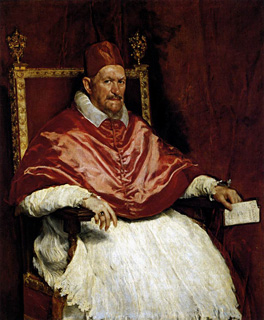Today is the birthday of John Paul II so this week I have chosen a picture with a pontifical theme. The portrait of Pope Innocent X, by the seventeenth-century Spanish artist Diego Rodriguez de Silva y Velazquez, can be seen in the Doria-Pamphili Palace in Rome, where it has been arousing the admiration of visitors for some four and a half centuries. The first president of the Royal Academy, Sir Joshua Reynolds, placed it “among the first portraits of the world”, a judgement echoed with a twang by the urbane American visitor to Rome in Henry James’s novella Daisy Miller, who singled it out as that “superb portrait of Innocent X by Valazquez” (sic). Closer to modern times, the painter Francis Bacon felt sufficiently challenged by the work to paint numerous pictures of his own directly inspired by its example.
The tersest and perhaps truest compliment to Velazquez’s masterpiece was paid by the sitter himself, who is said simply to have commented that it was “troppo vero”: too true to life. For all the splendour of his costume and for all the gilded, velvety richness of his setting, Velazquez’ image of the ageing but doughty pontiff is memorable above all for the complicated humanity of the sitter’s expression: a look in which suspicion, volatility of temperament, consciousness of power and the calculating instincts of a master of realpolitik seem to coexist with a strong sense of encroaching mortality.
Innocent X was in his seventy-sixth year when the work was painted, while Velazquez was fifty and at the height of his powers. The artist was principal painter to King Philip IV of Spain at the time. The circumstances behind his journey to Rome are explained by Velazquez’s early biographer, Palomino: “In the year 1648, he was sent...


